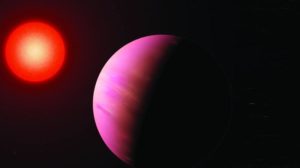 Washington: Using data from NASA’s Kepler space telescope, citizen scientists have discovered a world roughly twice the size of Earth located within its star’s habitable zone, the range of orbital distances where liquid water may exist on the planet’s surface.
Washington: Using data from NASA’s Kepler space telescope, citizen scientists have discovered a world roughly twice the size of Earth located within its star’s habitable zone, the range of orbital distances where liquid water may exist on the planet’s surface.
The new world, known as K2-288Bb, could be rocky or could be a gas-rich planet similar to Neptune. Its size is rare among exoplanets — planets beyond our solar system, according to the study published in the Astronomical Journal. “It’s a very exciting discovery due to how it was found, its temperate orbit and because planets of this size seem to be relatively uncommon,” said Adina Feinstein, a graduate student at the University of Chicago in the US.
Located 226 light-years away in the constellation Taurus, the planet lies in a stellar system known as K2-288, which contains a pair of dim, cool M-type stars separated by about 8.2 billion kilometers — roughly six times the distance between Saturn and the Sun.
The brighter star is about half as massive and large as the Sun, while its companion is about one-third the Sun’s mass and size. The new planet, K2-288Bb, orbits the smaller, dimmer star every 31.3 days. The researchers searched Kepler data for evidence of transits, the regular dimming of a star when an orbiting planet moves across the star’s face.
Examining data from the fourth observing campaign of Kepler’s K2 mission, the team noticed two likely planetary transits in the system.
In Kepler’s K2 mode, which ran from 2014 to 2018, the spacecraft repositioned itself to point at a new patch of sky at the start of each three-month observing campaign.
“Re-orienting Kepler relative to the Sun caused miniscule changes in the shape of the telescope and the temperature of the electronics, which inevitably affected Kepler’s sensitive measurements in the first days of each campaign,” said Geert Barentsen, an astrophysicist at NASA’s Ames Research Center.
To deal with this, early versions of the software that was used to prepare the data for planet-finding analysis simply ignored the first few days of observations — and that is where the third transit was hiding.
“We eventually re-ran all data from the early campaigns through the modified software and then re-ran the planet search to get a list of candidates, but these candidates were never fully visually inspected,” said Joshua Schlieder, an astrophysicist at NASA’s Goddard Space Flight Center.
The re-processed data were posted directly to Exoplanet Explorers, a project where the public searches Kepler’s K2 observations to locate new transiting planets.
In May 2017, volunteers noticed the third transit and began an excited discussion about what was then thought to be an Earth-sized candidate in the system, which caught the attention of Feinstein and her colleagues.
“That’s how we missed it — and it took the keen eyes of citizen scientists to make this extremely valuable find and point us to it,” Feinstein said.
The team began follow-up observations using NASA’s Spitzer Space Telescope, the Keck II telescope at the W M Keck Observatory and NASA’s Infrared Telescope Facility, and also examined data from ESA’s (the European Space Agency’s) Gaia mission.
Estimated to be about 1.9 times Earth’s size, K2-288Bb is half the size of Neptune.
























